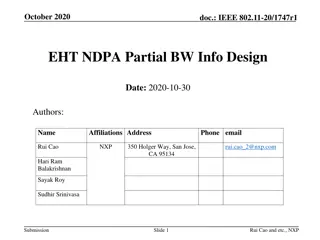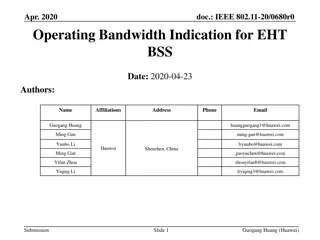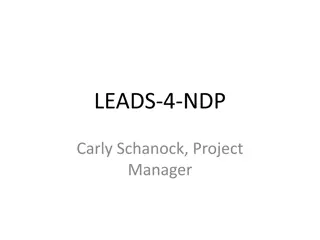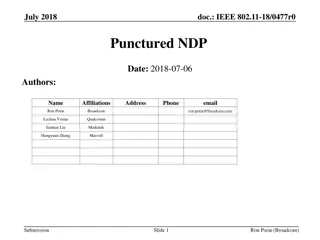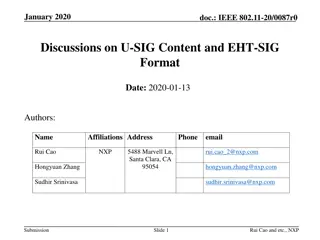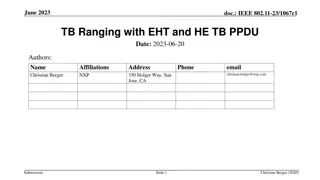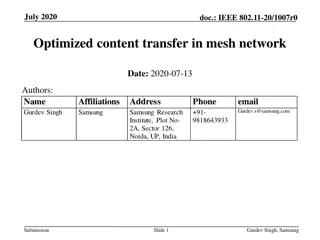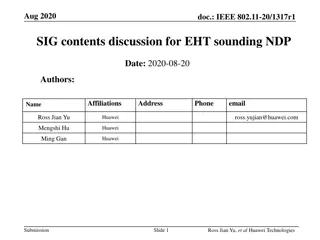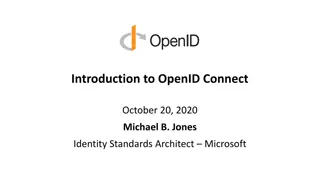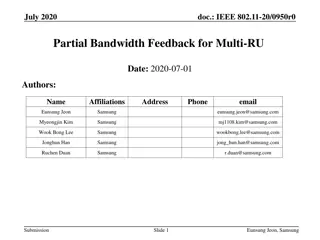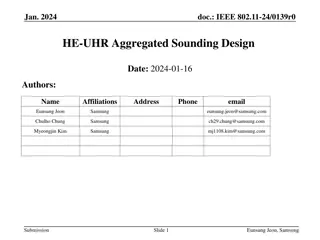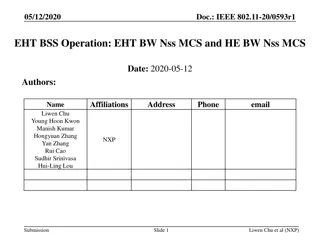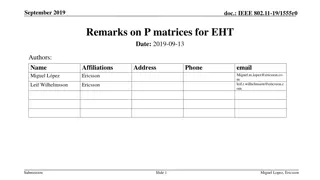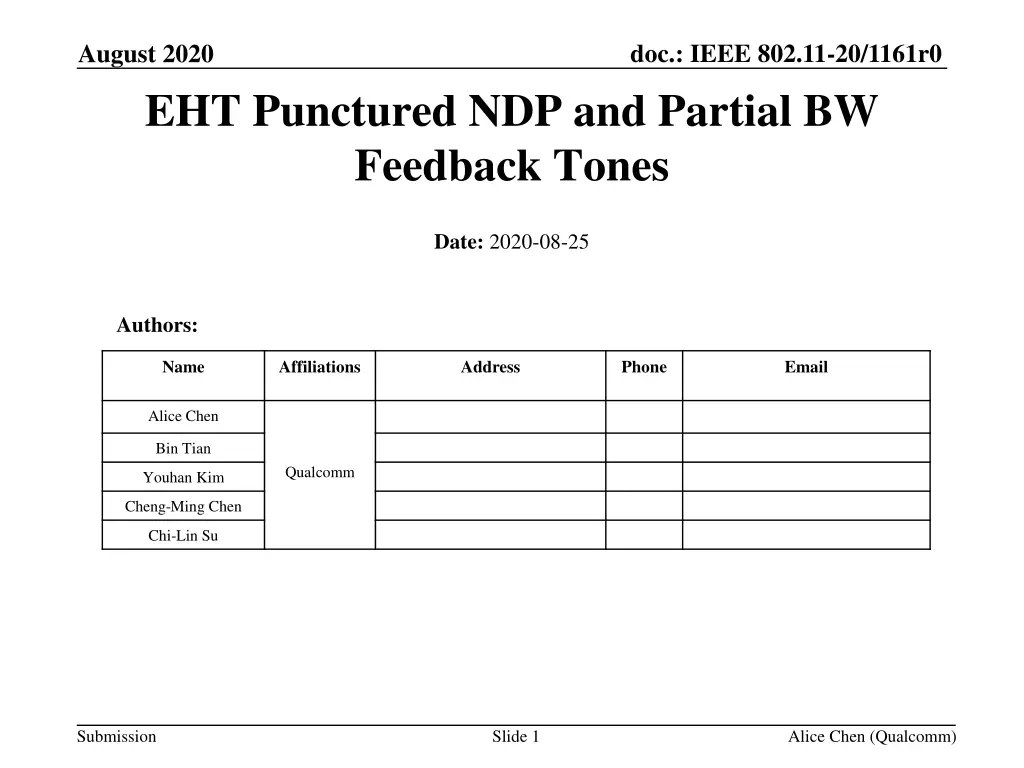
Enhancements to IEEE 802.11-20/1161r0 for August 2020
Explore the proposed changes to punctured NDP in IEEE 802.11-20/1161r0 for sounding and CSI feedback, focusing on areas such as granular feedback requests, feedback tone sets, and partial BW CSI feedback. The shift to EHT80 tone plan from HE80 may result in adjustments in various aspects compared to 11ax standards.
Download Presentation

Please find below an Image/Link to download the presentation.
The content on the website is provided AS IS for your information and personal use only. It may not be sold, licensed, or shared on other websites without obtaining consent from the author. If you encounter any issues during the download, it is possible that the publisher has removed the file from their server.
You are allowed to download the files provided on this website for personal or commercial use, subject to the condition that they are used lawfully. All files are the property of their respective owners.
The content on the website is provided AS IS for your information and personal use only. It may not be sold, licensed, or shared on other websites without obtaining consent from the author.
E N D
Presentation Transcript
doc.: IEEE 802.11-20/1161r0 August 2020 EHT Punctured NDP and Partial BW Feedback Tones Date: 2020-08-25 Authors: Name Affiliations Address Phone Email Alice Chen Bin Tian Qualcomm Youhan Kim Cheng-Ming Chen Chi-Lin Su Submission Slide 1 Alice Chen (Qualcomm)
doc.: IEEE 802.11-20/1161r0 August 2020 Abstract In this presentation, we would like to discuss changes to punctured NDP for sounding and CSI feedback in the following areas Punctured NDP for sounding CSI feedback request granularity Feedback tone set Partial BW CSI feedback Start/End tone indices table Note that it has been agreed that the EHT80 OFDMA tone plan for RU<996 will be changed from the HE80 OFDMA tone plan to duplication of two HE40 SU/OFDMA tone plans This tone plan change may lead to some changes in the aforementioned areas, compared to 11ax Submission Slide 2 Alice Chen (Qualcomm)
doc.: IEEE 802.11-20/1161r0 August 2020 Recap: HE80 Versus EHT80 EHT80 tone plan: DUPed HE40 for OFDMA + RU996 for SU 5 D C 5 D C 5 D C 5 D C 12 Edge 23 DC 11 Edge 26 26 26 26 26 26 26 26 26 26 26 26 26 26 26 2 26 26 26 26 26 26 26 26 26 1 1 2 2 26 26 26 26 26 26 26 26 2 1 1 1 1 2 26 26 26 26 1 1 2 2 1 1 1 1 1 1 2 1 1 12 Edge 23 DC 11 Edge 52 52 52 52 52 52 52 52 52 52 52 52 52 52 26 52 52 26 26 1 2 1 26 1 2 1 1 2 1 1 2 1 1 2 1 1 2 1 1 2 1 1 2 1 5 D C 5 D C 23 DC 11 Edge 106 106 106 106 106 106 106 106 26 26 26 26 1 1 1 1 1 1 1 1 1 1 1 1 1 1 1 1 12 Edge 5 D C 5 D C 23 DC 11 Edge 12 Edge 242 242 242 242 23 DC 11 Edge 484+5 484 + 5 12 Edge 12 Edge 996 usable tones +5 DC 11 Edge EHT80 HE80 tone plan 2 6 2 6 1 3 1 3 1 3 1 3 7 DC 11 Edge 12 Edge 26 26 26 26 26 26 26 26 26 26 26 26 26 26 26 26 26 26 26 26 26 26 26 26 26 26 26 26 26 26 26 26 26 26 26 26 1 26 26 1 1 2 2 1 2 1 2 1 1 1 2 2 1 2 1 1 1 2 2 2 7 DC 11 Edge 52 52 52 52 52 52 52 52 52 52 52 52 52 52 52 52 52 52 52 52 26 26 1 26 1 26 2 12 Edge 1 2 1 2 1 1 1 2 1 1 1 2 2 1 2 1 2 2 2 11 Edge 1 3 7 DC 12 Edge 106 106 106 106 106 106 106 106 13 26 26 26 26 1 1 2 1 1 2 1 1 1 1 1 1 1 1 1 3 1 3 1 3 1 3 11 Edge 7 DC 12 Edge 242 242 242 242 7 DC 11 Edge 484 484 12 Edge 12 Edge 996 usable tones +5 DC 11 Edge HE80 Submission Slide 3 Alice Chen (Qualcomm)
doc.: IEEE 802.11-20/1161r0 August 2020 LTF in Punctured NDP: 80MHz The non-punctured 80MHz NDP uses non-OFDMA tone plan, same as in 11ax For punctured NDP, propose to use OFDMA tone plan for EHT-LTF for 80MHz PPDUs and each 80MHz segment within >80MHz PPDUs The populated LTF tones for 1x/2x/4x EHT-LTF are listed in the following table The cases with a 40MHz punctured are for each 80MHz segment within >80MHz PPDUs RU & Tone Indices RU996, [-500:-3, 3:500] RU242+484, [-253:-12, 12:253, 259:500] RU242+484, [-500:-259, 12:253, 259:500] RU242+484, [-500:-259, - 253:-12, 259:500] RU242+484, [-500:-259, - 253:-12, 12:253] 1x LTF Tones A=[-500:4:-4, 4:4:+500] B1=[-252:4:-12, 12:4:252, 260:4:500] B2=[-500:4:-260, 12:4:252, 260:4:500] B3=[-500:4:-260, - 252:4:-12, 260:4:500] B4=[-500:4:-260, - 252:4:-12, 12:4:252] C1=[12:4:252, 260:4:500] C2=[-500:4:-260, - 252:4:-12] 2x LTF Tones A=[-500:2:-4, 4:2:500] B1=[-252:2:-12, 12:2:252, 260:2:500] B2=[-500:2:-260, 12:2:252, 260:2:500] B3=[-500:2:-260, - 252:2:-12, 260:2:500] B4=[-500:2:-260, - 252:2:-12, 12:2:252] C1=[12:2:252, 260:2:500] C2=[-500:2:-260, - 252:2:-12] 4x LTF Tones A=[-500:-3, 3:500] B1=[-253:-12, 12:253, 259:500] B2=[-500:-259, 12:253, 259:500] B3=[-500:-259, -253:-12, 259:500] B4=[-500:-259, -253:-12, 12:253] Non-punctured 1st 20MHz punctured 2nd 20MHz punctured 3rd 20MHz punctured 4th 20MHz punctured 1st 40MHz punctured 2nd 40MHz punctured RU484, [12:253, 259:500] C1=[12:253, 259:500] RU484, [-500:-259, -253:-12] C2=[-500:-259, -253:-12] Submission Slide 4 Alice Chen (Qualcomm)
doc.: IEEE 802.11-20/1161r0 August 2020 LTF in Punctured NDP: >80MHz For >80MHz PPDUs, different 80MHz segment may have different LTF populated tones, according to the puncturing pattern Example 1: For 160MHz, if the 1st 20MHz is punctured, the LTF populated tones are [B1 - 512, A + 512] Example 2: For 160MHz, if the 3rd 40MHz is punctured, the LTF populated tones are [A - 512, C1 + 512] Example 3: For 320MHz, if the 2nd 80MHz is punctured, the LTF populated tones are [A - 1536, A + 512, A + 1536] Example 4: For 320MHz, if the last 40MHz is punctured, the LTF populated tones are [A - 1536, A - 512, A + 512, C2 + 1536] Example 5: For 240MHz transmission, if the 4th 40MHz within the contiguous 240MHz is punctured, the LTF populated tones are [A - 1536, C2 - 512, A + 512] or [A - 512, C2 + 512, A + 1536] Submission Slide 5 Alice Chen (Qualcomm)
doc.: IEEE 802.11-20/1161r0 August 2020 CSI Feedback Request Granularity 11ax partial BW CSI feedback with RU26 granularity seems to be over-designed Flexibility allowed by 11ax cannot be realistically utilized by AP (e.g., RU allocated to a STA may vary in size across PPDUs). Increased complexity for STAs to support this feature, making it unappealing In practice, AP is more likely to request feedback with larger granularity, e.g., 20MHz Propose to restrict the CSI feedback request granularity, which is indicated in NDPA, with 20MHz (essentially RU242) granularity for 11be How to indicate RU_start & RU_end in 11be NDPA is TBD Note this change is only on the feedback request granularity. It doesn t affect feedback computation. For example, CQI feedback computation is still based on RU26 granularity (the same as 11ax) but according to 11be tone plan Submission Slide 6 Alice Chen (Qualcomm)
doc.: IEEE 802.11-20/1161r0 August 2020 Feedback Tone Set (1/2) 20/40MHz: Reuse 11ax feedback tone sets for 11be 80MHz: Define feedback tone sets based on duplication of the feedback tone set of 40MHz plus extra feedback tones Ng=4: Reuse the 11ax feedback tones of Ng=4 for 11be Note that we can rewrite 11ax feedback tone set X=[-500:4:-4, 4:4:500] as [[-244:4:-4, 0, 4:4:244]-256, -8, -4, 4, 8, [-244:4:-4, 0, 4:4:244]+256] which consists of duplication of feedback tones of HE40 (i.e., [-244:4:-4, 4:4:244]) plus 6 additional feedback tones ( 4, 8, 256) Ng=16: Redefine the feedback tones of Ng=16 for 11be by shifting the 11ax feedback tones of Ng=16 within 2nd & 3rd 20MHz (i.e., [-244:16:-4] and [4:16:244]) by -8 and 8 tones, respectively, plus 2 additional feedback tones ( 4): X=[-500:16:-260, -252:16:-12, -4, 4, 12:16:252, 260:16:500] Note that we can rewrite the feedback tone set as [[-244:16:-4, 4:16:244]-256, -4, 4, [- 244:16:-4, 4:16:244]+256], which consists of duplication of feedback tones of HE40 (i.e., [-244:16:-4, 4:16:244]) plus 2 additional feedback tones ( 4) Submission Slide 7 Alice Chen (Qualcomm)
doc.: IEEE 802.11-20/1161r0 August 2020 Feedback Tone Set (2/2) 160/320MHz: Duplicate the feedback tone set of 80MHz 160MHz: Use the feedback tone set [X - 512, X + 512] 320MHz: Use the feedback tone set [X - 1536, X - 512, X + 512, X + 1536] This is to reuse the 11ax rule of defining feedback tone set for >80MHz The feedback tone set is used for the full BW CSI feedback Submission Slide 8 Alice Chen (Qualcomm)
doc.: IEEE 802.11-20/1161r0 August 2020 Partial BW CSI Feedback Start/End Tone Indices Table 11ax partial BW CSI feedback Start/End tone indices tables (Tables 9-93c & 9-93d) are not suitable for 11be 11ax tables are not aligned with RU26 in 2nd and 3rd 20MHz in EHT80 tone plan The RU26 indices are different: 11ax has 37 RU26 but 11be has 36 RU26 11ax tables with RU26 granularity may not be efficient when the CSI feedback request uses 20MHz (essentially RU242) granularity Propose to redesign feedback start/end tone indices tables for 11be based on new EHT80 OFDMA tone plan with RU242 granularity Table with same S/E indices for Ng=4 and Ng=16 in next slide The feedback tones for each RU242 are [S:Ng:E], which is a subset of the feedback tone set of the PPDU BW Submission Slide 9 Alice Chen (Qualcomm)
doc.: IEEE 802.11-20/1161r0 August 2020 Partial BW CSI Feedback with 20MHz (RU242) Granularity Propose the following table for both Ng=4 and Ng=16 20MHz S -122 40MHz S -244 4 80MHz S -500 -252 12 260 160MHz S 320MHz S RU242 Index 0 1 2 3 4 5 6 7 8 9 10 11 12 13 14 15 E E -4 244 E E E 122 -260 -1012 -772 -2036 -1796 -12 -764 -524 -1788 -1548 252 -500 -260 -1524 -1284 500 -252 -12 12 252 -1012 -772 260 500 524 764 772 1012 -252 -1276 -1036 -764 -500 -524 -260 -12 252 500 764 1012 12 260 524 772 1036 1276 1284 1524 1548 1788 1796 2036 Submission Slide 10 Alice Chen (Qualcomm)
doc.: IEEE 802.11-20/1161r0 August 2020 Determine Feedback Tones 80MHz 6 additional feedback tones ( 4, 8, 256) in Ng=4 and 2 additional feedback tones ( 4) are not in any RU242 If the requested feedback tone range is full BW (i.e., from the 0th to last RU), the entire feedback tone set X is fed back, i.e., in addition to the feedback tones in each RU242, the aforementioned additional feedback tones are required to be fed back Each 80MHz segment within 160MHz / 320MHz If the requested feedback range (RU_start, RU_end) covers entire 80MHz segment, the feedback tone set includes the entire feedback tone set of the particular 80MHz which consist of the feedback tones of all four RU242s plus aforementioned additional tones E.g., if the 1st 80MHz within 160MHz is requested, the feedback tone set is [X - 512] If the requested feedback range doesn t cover entire 80MHz segment, the feedback tone set consists of all the feedback tones of the RU242 within the specified range E.g., if the 1st 40MHz within 320MHz is requested, the feedback tone set is [-2036:Ng:- 1796, -1788:Ng:-1548] Submission Slide 11 Alice Chen (Qualcomm)
doc.: IEEE 802.11-20/1161r0 August 2020 SP 1 Do you support that for 80MHz NDP or each 80 MHz segment of >80MHz bandwidth NDP If not punctured, using non-OFDMA 80 MHz tone plan If punctured, using OFDMA 80MHz tone plan RU & Tone Indices RU996, [-500:-3, 3:500] RU242+484, [-253:-12, 12:253, 259:500] RU242+484, [-500:-259, 12:253, 259:500] RU242+484, [-500:-259, - 253:-12, 259:500] RU242+484, [-500:-259, - 253:-12, 12:253] 1x LTF Tones A=[-500:4:-4, 4:4:+500] B1=[-252:4:-12, 12:4:252, 260:4:500] B2=[-500:4:-260, 12:4:252, 260:4:500] B3=[-500:4:-260, - 252:4:-12, 260:4:500] B4=[-500:4:-260, - 252:4:-12, 12:4:252] C1=[12:4:252, 260:4:500] C2=[-500:4:-260, - 252:4:-12] 2x LTF Tones A=[-500:2:-4, 4:2:500] B1=[-252:2:-12, 12:2:252, 260:2:500] B2=[-500:2:-260, 12:2:252, 260:2:500] B3=[-500:2:-260, - 252:2:-12, 260:2:500] B4=[-500:2:-260, - 252:2:-12, 12:2:252] C1=[12:2:252, 260:2:500] C2=[-500:2:-260, - 252:2:-12] 4x LTF Tones A=[-500:-3, 3:500] B1=[-253:-12, 12:253, 259:500] B2=[-500:-259, 12:253, 259:500] B3=[-500:-259, -253:-12, 259:500] B4=[-500:-259, -253:-12, 12:253] Non-punctured 1st 20MHz punctured 2nd 20MHz punctured 3rd 20MHz punctured 4th 20MHz punctured 1st 40MHz punctured 2nd 40MHz punctured RU484, [12:253, 259:500] C1=[12:253, 259:500] RU484, [-500:-259, -253:-12] C2=[-500:-259, -253:-12] Y/N/A Submission Slide 12 Alice Chen (Qualcomm)
doc.: IEEE 802.11-20/1161r0 August 2020 SP 2 Do you support the following feedback tone sets for 11be? 20/40MHz: Reuse 11ax feedback tone sets for 11be 80MHz Ng=4: Reuse the 11ax feedback tones of Ng=4 for 11be Ng=16: Redefine the feedback tones of Ng=16 for 11be as [-500:16:-260, -252:16:-12, -4, 4, 12:16:252, 260:16:500] 160/320MHz: Duplicate the feedback tone set of 80MHz Full BW sounding feedback entire tone set Y/N/A Submission Slide 13 Alice Chen (Qualcomm)
doc.: IEEE 802.11-20/1161r0 August 2020 SP 3 Do you support the following for 11be? The partial BW CSI feedback request uses 20MHz (RU242) granularity Note: Feedback request granularity change doesn t impact the CSI computation scheme. For example, CQI feedback computation is still based on RU26 Y/N/A Submission Slide 14 Alice Chen (Qualcomm)
doc.: IEEE 802.11-20/1161r0 August 2020 SP 4 Do you support the following feedback start/end tone indices table with RU242 granularity for both Ng=4 and Ng=16 for 11be? If feedback request does not cover entire 80MHz segment, use the following table If feedback request covers entire 80MHz segment, feedback the entire 80MHz segment feedback tone set 20MHz 40MHz 80MHz 160MHz S -1012 -764 -500 -252 12 260 524 772 320MHz S -2036 -1788 -1524 -1276 -1012 -764 -500 -252 12 260 524 772 1036 1284 1548 1796 RU242 Index S E S E -4 244 S E E E 0 1 2 3 4 5 6 7 8 9 -122 122 -244 4 -500 -252 12 260 -260 -12 252 500 -772 -524 -260 -12 252 500 764 1012 -1796 -1548 -1284 -1036 -772 -524 -260 -12 252 500 764 1012 1276 1524 1788 2036 10 11 12 13 14 15 Y/N/A Submission Slide 15 Alice Chen (Qualcomm)


